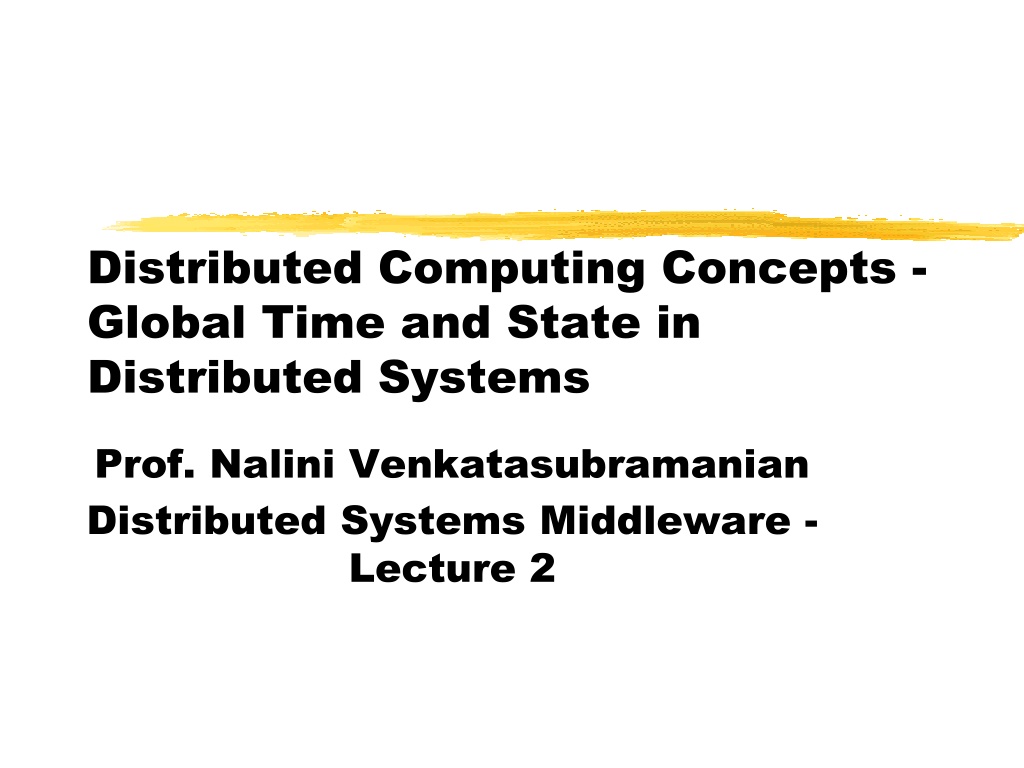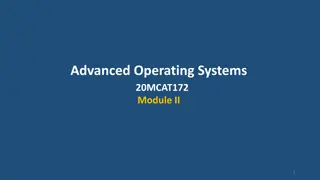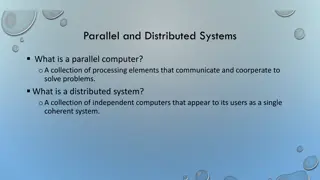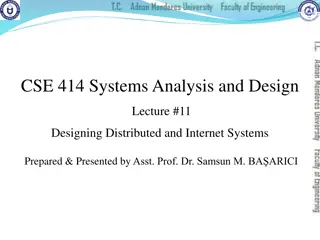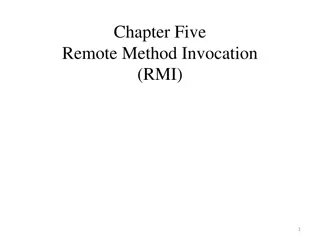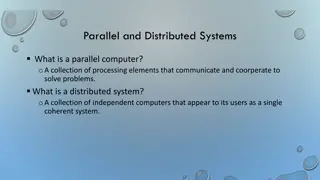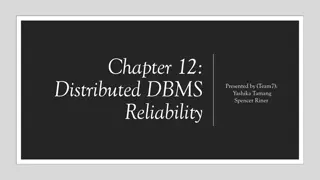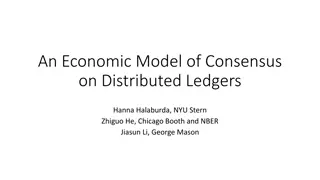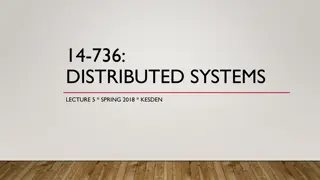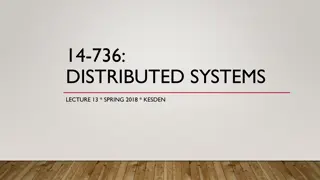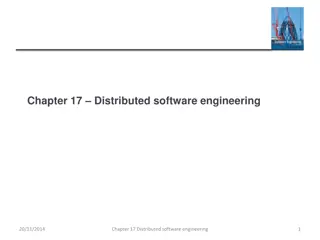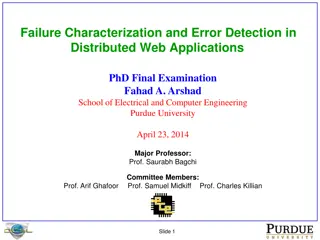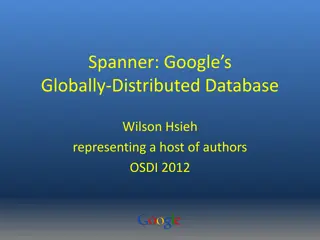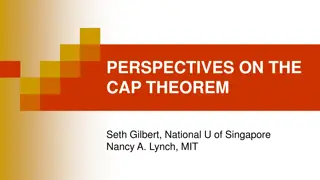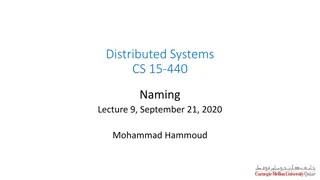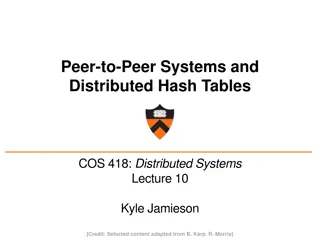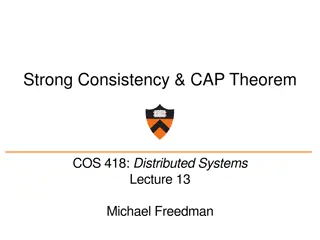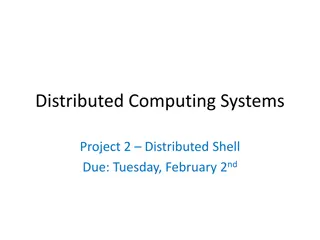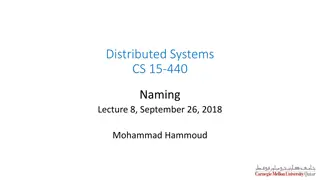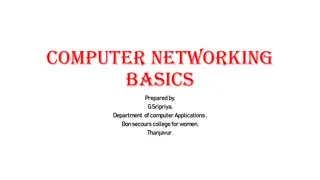Global Time and State in Distributed Systems
Distributed systems face challenges in achieving global time and state due to asynchronous processes with unpredictable delays. Various techniques are utilized to simulate synchronous systems and approximate global views. The concept of time in distributed systems involves partial order structures and the necessity of clock synchronization for accurate operation in different applications. Physical vs. logical clocks play a crucial role in event causality determination.
Download Presentation

Please find below an Image/Link to download the presentation.
The content on the website is provided AS IS for your information and personal use only. It may not be sold, licensed, or shared on other websites without obtaining consent from the author.If you encounter any issues during the download, it is possible that the publisher has removed the file from their server.
You are allowed to download the files provided on this website for personal or commercial use, subject to the condition that they are used lawfully. All files are the property of their respective owners.
The content on the website is provided AS IS for your information and personal use only. It may not be sold, licensed, or shared on other websites without obtaining consent from the author.
E N D
Presentation Transcript
Distributed Computing Concepts - Global Time and State in Distributed Systems Prof. Nalini Venkatasubramanian Distributed Systems Middleware - Lecture 2
Global Time & Global States of Distributed Systems Asynchronous processes without common memory which communicate (solely) via messages with unpredictable transmission delays Global time & global state are hard to realize in distributed systems Rate of event occurrence is very high Event execution times are very small We can only approximate the global view Simulate synchronous distributed system on a given asynchronous system Simulate a global time Clocks (Physical and Logical) Simulate a global state Global Snapshots distributed systems consist of several
Simulate Synchronous Distributed Systems Synchronizers [Awerbuch 85] Simulate clock pulses in such a way that a message is only generated at a clock pulse and will be received before the next pulse Drawback Very high message overhead
The Concept of Time in Distributed Systems A standard time is a set of instants with a temporal precedence order < satisfying certain conditions [Van Benthem 83]: Irreflexivity Transitivity Linearity Eternity ( x y: x<y) Density ( x,y: x<y z: x<z<y) Transitivity and Irreflexivity imply asymmetry A linearly ordered structure of time is not always adequate for distributed systems Captures dependence, not independence of distributed activities Time as a partial order A partially ordered system of vectors forming a lattice structure is a natural representation of time in a distributed system.
Global time in distributed systems An accurate notion of global time is difficult to achieve in distributed systems. Uniform notion of time is necessary for correct operation of many applications (mission critical distributed control, online games/entertainment, financial apps, smart environments etc.) Clocks in a distributed system drift Relative to each other Relative to a real world clock Determination of this real world clock itself may be an issue Clock synchronization is needed to simulate global time Physical Clocks vs. Logical clocks Physical clocks are logical clocks that must not deviate from the real-time by more than a certain amount. We often derive causality of events from loosely synchronized clocks
Physical Clocks Duration in mean solar time 24 hours 24 hours 18.1 seconds 24 hours 24 hours + 13.1 seconds 24 hours 24 hours 21.3 seconds 24 hours 24 hours + 29.9 seconds How do we measure real time? 17th century - Mechanical clocks based on astronomical measurements Solar Day - Transit of the sun Solar Seconds - Solar Day/(3600*24) Problem (1940) - Rotation of the earth varies (gets slower) Mean solar second - average over many days Date February 11 March 26 May 14 June 19 July 26 September 16 November 3 December 22 Length of apparent solar day (1998) (cf: wikipedia)
Atomic Clocks 1948 - Counting transitions of a crystal (Cesium 133, quartz) used as atomic clock crystal oscillates at a well known frequency 2014 NIST-F2 Atomic clock Accuracy: 1 sec in 300 mil years NIST-F2 measures particular transitions in Cesium atom (9,192,631,770 vibrations per second), in much colder environment, minus 316F, than NIST-F1 TAI - International Atomic Time 9,192,631,779 transitions = 1 mean solar second in 1948 UTC (Universal Coordinated Time) From time to time, UTC skips a solar second to stay in phase with the sun (30+ times since 1958) UTC is broadcast by several sources (satellites )
How Clocks Work in Computers Oscillation at a well- defined frequency Quartz crystal Holding register Each crystal oscillation decrements the counter by 1 When counter gets 0, its value reloaded from the holding register Counter When counter is 0, an interrupt is generated, which is call a clock tick CPU At each clock tick, an interrupt service procedure add 1 to time stored in memory Memory From Distributed Systems (cs.nju.edu.cn/distribute-systems/lecture-notes/ 9
Accuracy of Computer Clocks Modern timer chips have a relative error of 1/100,000 - 0.86 seconds a day To maintain synchronized clocks Can use UTC source (time server) to obtain current notion of time Use solutions without UTC.
Cristians (Time Server) Algorithm Uses a time server to synchronize clocks Time server keeps the reference time (say UTC) A client asks the time server for time, the server responds with its current time, and the client uses the received value to set its clock But network round-trip time introduces errors Let RTT = response-received-time request-sent-time (measurable at client), If we know (a) min = minimum client-server one-way transmission time and (b) that the server timestamped the message at the last possible instant before sending it back Then, the actual time could be between [T+min,T+RTT min]
Cristians Algorithm Client sets its clock to halfway between T+minand T+RTT min i.e., at T+RTT/2 Expected (i.e., average) skew in client clock time = (RTT/2 min) Can increase clock value, should never decrease it. Can adjust speed of clock too (either up or down is ok) Multiple requests to increase accuracy For unusually long RTTs, repeat the time request For non-uniform RTTs Drop values beyond threshold; Use averages (or weighted average)
Berkeley UNIX algorithm One Version One daemon without UTC Periodically, this daemon polls and asks all the machines for their time The machines respond. The daemon computes an average time and then broadcasts this average time. Another Version Master/daemon uses Cristian s algorithm to calculate time from multiple sources, removes outliers, computes average and broadcasts
Decentralized Averaging Algorithm Each machine has a daemon without UTC Periodically, at fixed agreed-upon times, each machine broadcasts its local time. Each of them calculates the average time by averaging all the received local times.
Network Time Protocol (NTP) Most widely used physical clock synchronization protocol on the Internet (http://www.ntp.org) Currently used: NTP V3 and V4 10-20 million NTP servers and clients in the Internet Claimed Accuracy (Varies) milliseconds on WANs, submilliseconds on LANs, submicroseconds using a precision timesource Nanosecond NTP in progress
NTP Design Hierarchical tree of time servers. The primary server at the root synchronizes with the UTC. The next level contains secondary servers, which act as a backup to the primary server. At the lowest level is the synchronization subnet which has the clients. Variant of Cristian s algorithm that does not use RTT s, but multiple 1-way messages
DCE Distributed Time Service Software service that provides precise, fault-tolerant clock synchronization for systems in local area networks (LANs) and wide area networks (WANs). determine duration, perform event sequencing and scheduling. Each machine is either a time server or a clerk software components on a group of cooperating systems; client obtains time from DTS entity DTS entities DTS server DTS clerk that obtain time from DTS servers on other hosts
Clock Synchronization in DCE DCE s time model is actually in an interval I.e. time in DCE is actually an interval Comparing 2 times may yield 3 answers t1 < t2, t2 < t1, not determined Periodically a clerk obtains time-intervals from several servers ,e.g. all the time servers on its LAN Based on their answers, it computes a new time and gradually converges to it. Compute the intersection where the intervals overlap. Clerks then adjust the system clocks of their client systems to the midpoint of the computed intersection. When clerks receive a time interval that does not intersect with the majority, the clerks declare the non-intersecting value to be faulty. Clerks ignore faulty values when computing new times, thereby ensuring that defective server clocks do not affect clients.
Causal Relations Distributed application results in a set of distributed events Induces a partial order causal precedence relation Knowledge of this causal precedence relation is useful in reasoning about and analyzing the properties of distributed computations Liveness and fairness in mutual exclusion Consistency in replicated databases Distributed debugging, checkpointing
Logical Clocks Used to determine causality in distributed systems Time is represented by non-negative integers Event structures represent distributed computation (in an abstract way) A process can be viewed as consisting of a sequence of events, where an event is an atomic transition of the local state which happens in no time Process Actions can be modeled using the 3 types of events Send Message Receive Message Internal (change of state)
Logical Clocks A logical Clock C is some abstract mechanism which assigns to any event e E the value C(e) of some time domain T such that certain conditions are met C:E T :: T is a partially ordered set : e<e C(e)<C(e ) holds Consequences of the clock condition [Morgan 85]: Events occurring at a particular process are totally ordered by their local sequence of occurrence If an event e occurs before event e at some single process, then event e is assigned a logical time earlier than the logical time assigned to event e For any message sent from one process to another, the logical time of the send event is always earlier than the logical time of the receive event Each receive event has a corresponding send event Future can not influence the past (causality relation)
Event Ordering Lamport defined the happens before (=>) relation If a and b are events in the same process, and a occurs before b, then a => b. If a is the event of a message being sent by one process and b is the event of the message being received by another process, then a => b. If X =>Y and Y=>Z then X => Z. If a => b then time (a) => time (b)
Event Ordering- the example Processor Order: e precedes e in the same process Send-Receive: e is a send and e is the corresponding receive Transitivity: exists e s.t. e < e and e < e Example: global time e11 e13 e12 e14 P1 Program order: Send-Receive: Transitivity: e13 < e14 e23 < e12 e21 < e32 e21 e22 e23 P2 e31 e32 P3
Causal Ordering Happens Before also called causal ordering Possible to draw a causality relation between 2 events if They happen in the same process There is a chain of messages between them Happens Before notion is not straightforward in distributed systems No guarantees of synchronized clocks Communication latency
Implementation of Logical Clocks Requires Data structures local to every process to represent logical time and a protocol to update the data structures to ensure the consistency condition. Each process Pi maintains data structures that allow it the following two capabilities: A local logical clock, denoted by LC_i , that helps process Pi measure its own progress. A logical global clock, denoted by GCi , that is a representation of process Pi s local view of the logical global time. Typically, lci is a part of gci The protocol ensures that a process s logical clock, and thus its view of the global time, is managed consistently. The protocol consists of the following two rules: R1: This rule governs how the local logical clock is updated by a process when it executes an event. R2: This rule governs how a process updates its global logical clock to update its view of the global time and global progress.
Types of Logical Clocks Systems of logical clocks differ in their representation of logical time and also in the protocol to update the logical clocks. 3 kinds of logical clocks Scalar Vector Matrix
Scalar Logical Clocks - Lamport Proposed by Lamport in 1978 as an attempt to totally order events in a distributed system. Time domain is the set of non-negative integers. The logical local clock of a process pi and its local view of the global time are squashed into one integer variable Ci . Monotonically increasing counter No relation with real clock Each process keeps its own logical clock used to timestamp events
Consistency with Scalar Clocks To guarantee the clock condition, local clocks must obey a simple protocol: When executing an internal event or a send event at process Pithe clock Citicks Ci+= d (d>0) When Pisends a message m, it piggybacks a logical timestamp t which equals the time of the send event When executing a receive event at Piwhere a message with timestamp t is received, the clock is advanced Ci= max(Ci,t)+d (d>0) Results in a partial ordering of events.
Total Ordering Extending partial order to total order time Proc_id Global timestamps: (Ta, Pa) where Ta is the local timestamp and Pa is the process id. (Ta,Pa) < (Tb,Pb) iff (Ta < Tb) or ( (Ta = Tb) and (Pa < Pb)) Total order is consistent with partial order.
Independence Two events e, e are mutually independent (i.e. e||e ) if ~(e<e ) ~(e <e) [none of them happened-before the other] Two events are independent if they have the same timestamp Events which are causally independent may get the same or different timestamps By looking at the timestamps of events it is not possible to assert that some event could not influence some other event If e < e , then C(e) < C(e ), but the converse is not true If C(e)<C(e ) then ~(e <e) however, it is not possible to decide whether e < e or e||e C is an order homomorphism which preserves < but it does not preserve negations
Vector Clocks Independently developed by Fidge, Mattern and Schmuck Aim: to get an optimal approximation of global time Unlike Lamport clock, time is not represented by a single number, instead by a vector of N elements: one for each N processes Each process maintains its own logical clock as well as the clocks at the other processes Each process sends out its vector clock when it sends a message The receiving process updates its vector clock
Structure of Vector Clocks For two time vectors u, v u v iff i: u[i] v[i] u<v iff u v u v u||v iff ~(u<v) ~(v<u) :: || is not transitive We can show that e < e if and only if V(e) < V(e ) If part is easy to show Can you prove the converse? [left as an exercise] In order to determine if two events e, e are causally related or not, just take their timestamps V(e) and V(e ) if V(e)<V(e ) V(e )<V(e), then the events are causally related Otherwise, they are causally independent
Vector Clocks Disadvantage of vector timestamps Storage and message payload #processes Techniques exist for storing and transmitting smaller amounts of data, at the expense of the processing required to reconstruct complete vectors (due to Raynal and Singhal 1996) There is also a notion of matrix clocks, whereby processes keep estimates of other processes vector times as well as their own Used in distributed garbage collection
Global States The state of all processes at a given time Individual process can record its own (local) state But, constructing a global state is hard! Why? Why do we need global states? Termination Deadlock detection
Global States: An Analogy Room 2 Room 3 Room 1 People are moving across three rooms Q: How do you count the number of total people in the system when you can only count from inside a room?
Event Diagram Time e11 e12 e13 P1 e21 e22 e23 e24 e25 P2 e32 e33 e34 P3 e31
Equivalent Event Diagram Time e11 e12 e13 P1 e21 e22 e23 e24 e25 P2 e32 e33 e34 P3 e31
Rubber band Event Diagram Time e11 e12 P1 e21 e22 P2 P3 e31 P4 e41 e42 cut
Cuts and Consistent Cuts A cut (or time slice) is a zigzag line cutting a time diagram into 2 parts (past and future) E is augmented with a cut event ci for each process Pi:E =E {ci, ,cn} A cut C of an event set E is a finite subset C E: e C e <le e C A cut C1is later than C2if C1 C2 A consistent cut C of an event set E is a finite subset C E : e C e <e e C i.e. a cut is consistent if every message received was previously sent (but not necessarily vice versa!) For a consistent cut C:
Consistent Cuts Instant of local observation (Cut event) Time P1 5 8 3 initial value P2 3 7 5 2 4 1 P3 4 0 5 ideal (vertical) cut consistent cut inconsistent cut not attainable equivalent to a vertical cut (rubber band transformation) can t be made vertical (message from the future)
Consistent Cuts Some Theorems For a consistent cut consisting of cut events ci, ,cn, no pair of cut events is causally related. i.e ci,cj~(ci< cj) ~(cj< ci) For any time diagram with a consistent cut consisting of cut events ci, ,cn, there is an equivalent time diagram where ci, ,cnoccur simultaneously. i.e. where the cut line forms a straight vertical line All cut events of a consistent cut can occur simultaneously
Global States of Consistent Cuts The global state of a distributed system is a collection of the local states of the processes and the channels. A global state computed along a consistent cut is correct The global state of a consistent cut comprises the local state of each process at the time the cut event happens and the set of all messages sent but not yet received The snapshot problem consists of designing an efficient protocol which yields consistent cuts in order to collect the local state information Messages crossing the cut must be captured Chandy & Lamport presented an algorithm assuming that message transmission is FIFO
System Model for Global Snapshots The system consists of a collection of n processes p1, p2, ..., pn that are connected by channels. There are no globally shared memory and physical global clock and processes communicate by passing messages through communication channels. Cijdenotes the channel from process pi to process pj and its state is denoted by SCij. The actions performed by a process are modeled as three types of events: Internal events, the message send event and the message receive event. For a message mij that is sent by process pi to process pj , let send(mij) and rec(mij) denote its send and receive events.
Chandy-Lamport Distributed Snapshot Algorithm Assumes FIFO communication in channels Uses a control message, called a marker to separate messages in the channels After a process has recorded its snapshot, it sends a marker, along all of its outgoing channels before sending out any more messages. The marker separates the messages in the channel into those to be included in the snapshot from those not to be recorded in the snapshot. A process must record its snapshot no later than when it receives a marker on any of its incoming channels. The algorithm terminates after each process has received a marker on all of its incoming channels. All the local snapshots get disseminated to all other processes and all the processes can determine the global state.
Chandy-Lamport Distributed Snapshot Algorithm Record own states ? p3 ? p2 p1 m p2 p3 ? m p3 p2 ? On receiving the marker, say on channel c, the receiving process records its state, set channel c empty, sends out the marker on all outgoing channels and starts recording messages arriving on those channels,
